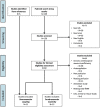Cerebrovascular Reactivity and Neurovascular Coupling in Multiple Sclerosis-A Systematic Review
- PMID: 35720104
- PMCID: PMC9198441
- DOI: 10.3389/fneur.2022.912828
Cerebrovascular Reactivity and Neurovascular Coupling in Multiple Sclerosis-A Systematic Review
Abstract
The inflammatory processes observed in the central nervous system in multiple sclerosis (MS) could damage the endothelium of the cerebral vessels and lead to a dysfunctional regulation of vessel tonus and recruitment, potentially impairing cerebrovascular reactivity (CVR) and neurovascular coupling (NVC). Impaired CVR or NVC correlates with declining brain health and potentially plays a causal role in the development of neurodegenerative disease. Therefore, we examined studies on CVR or NVC in MS patients to evaluate the evidence for impaired cerebrovascular function as a contributing disease mechanism in MS. Twenty-three studies were included (12 examined CVR and 11 examined NVC). Six studies found no difference in CVR response between MS patients and healthy controls. Five studies observed reduced CVR in patients. This discrepancy can be because CVR is mainly affected after a long disease duration and therefore is not observed in all patients. All studies used CO2 as a vasodilating stimulus. The studies on NVC demonstrated diverse results; hence a conclusion that describes all the published observations is difficult to find. Future studies using quantitative techniques and larger study samples are needed to elucidate the discrepancies in the reported results.
Keywords: cerebral blood flow (CBF); cerebrovascular disease; cerebrovascular hemodynamics; cerebrovascular reactivity (CVR); multiple sclerosis; neurovascular coupling (NVC).
Copyright © 2022 Vestergaard, Frederiksen, Larsson and Cramer.
Conflict of interest statement
The authors declare that the research was conducted in the absence of any commercial or financial relationships that could be construed as a potential conflict of interest.
Figures
Similar articles
-
Impaired cerebrovascular reactivity in multiple sclerosis.JAMA Neurol. 2014 Oct;71(10):1275-81. doi: 10.1001/jamaneurol.2014.1668. JAMA Neurol. 2014. PMID: 25133874 Free PMC article.
-
Influence of CO2 on neurovascular coupling: interaction with dynamic cerebral autoregulation and cerebrovascular reactivity.Physiol Rep. 2014 Mar 27;2(3):e00280. doi: 10.1002/phy2.280. Print 2014. Physiol Rep. 2014. PMID: 24760531 Free PMC article.
-
Effects of cerebral ischemia on human neurovascular coupling, CO2 reactivity, and dynamic cerebral autoregulation.J Appl Physiol (1985). 2015 Jan 15;118(2):170-7. doi: 10.1152/japplphysiol.00620.2014. Epub 2014 Nov 13. J Appl Physiol (1985). 2015. PMID: 25593216
-
Neuroimaging Assessment of Cerebrovascular Reactivity in Concussion: Current Concepts, Methodological Considerations, and Review of the Literature.Front Neurol. 2016 Apr 29;7:61. doi: 10.3389/fneur.2016.00061. eCollection 2016. Front Neurol. 2016. PMID: 27199885 Free PMC article. Review.
-
The Utility of Cerebrovascular Reactivity MRI in Brain Rehabilitation: A Mechanistic Perspective.Front Physiol. 2021 Mar 17;12:642850. doi: 10.3389/fphys.2021.642850. eCollection 2021. Front Physiol. 2021. PMID: 33815146 Free PMC article. Review.
Cited by
-
Age-related decline in cerebral oxygen consumption in multiple sclerosis.J Cereb Blood Flow Metab. 2024 Jun;44(6):1039-1052. doi: 10.1177/0271678X231224502. Epub 2024 Jan 8. J Cereb Blood Flow Metab. 2024. PMID: 38190981 Free PMC article.
-
Differentiation of MS lesions through analysis of microvascular distribution.Imaging Neurosci (Camb). 2024 Nov 8;2:imag-2-00357. doi: 10.1162/imag_a_00357. eCollection 2024. Imaging Neurosci (Camb). 2024. PMID: 40800329 Free PMC article.
-
Investigation of neuro-vascular reactivity on fMRI study during visual activation in people with multiple sclerosis using EEG and hypercapnia challenge.Med Phys. 2025 Jun;52(6):5081-5090. doi: 10.1002/mp.17772. Epub 2025 Mar 21. Med Phys. 2025. PMID: 40116356 Free PMC article.
-
Disrupted hemodynamic response within dorsolateral prefrontal cortex during cognitive tasks among people with multiple sclerosis-related fatigue.PLoS One. 2024 Jun 5;19(6):e0303211. doi: 10.1371/journal.pone.0303211. eCollection 2024. PLoS One. 2024. PMID: 38837991 Free PMC article.
References
Publication types
LinkOut - more resources
Full Text Sources


